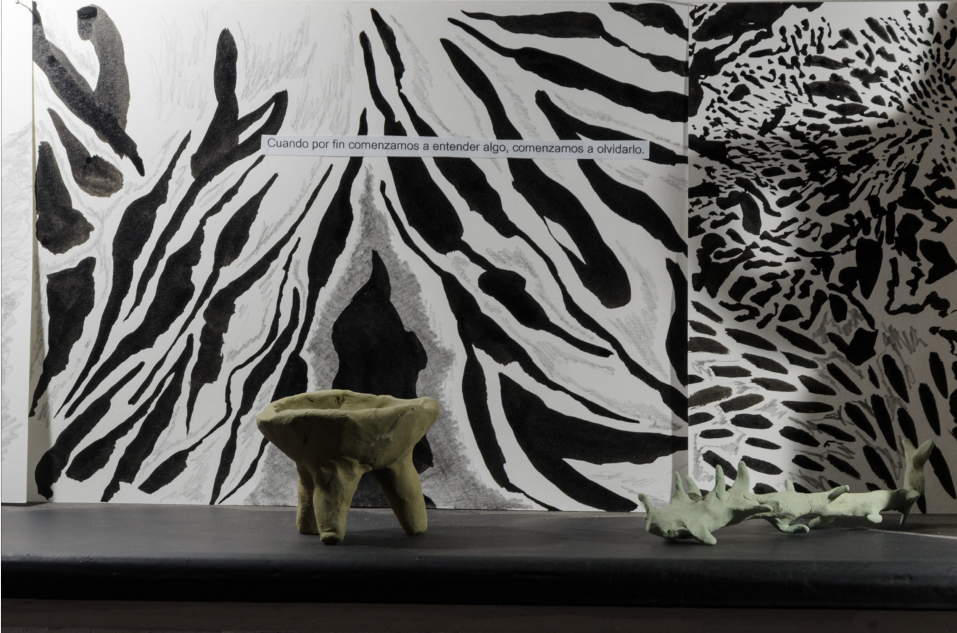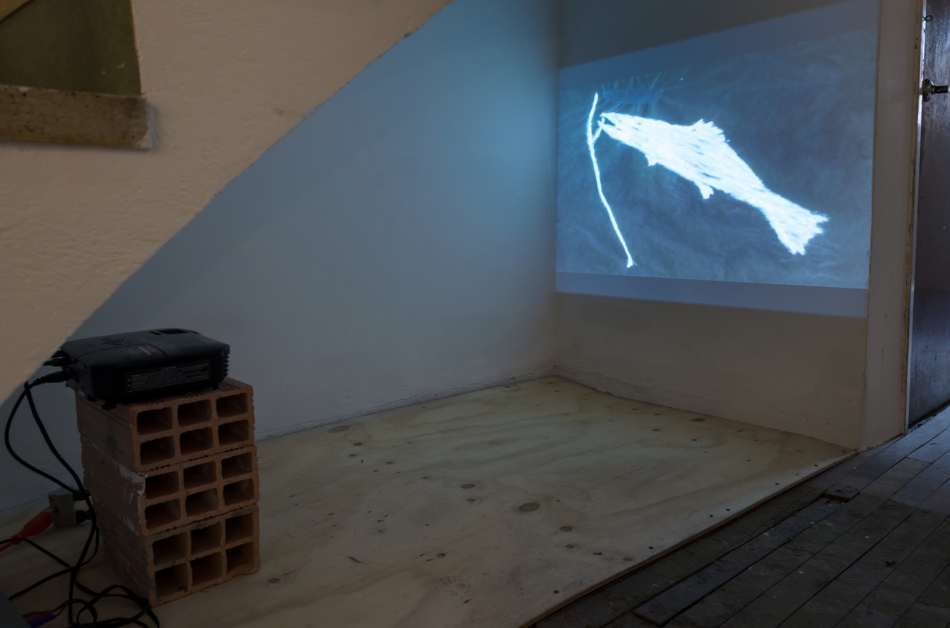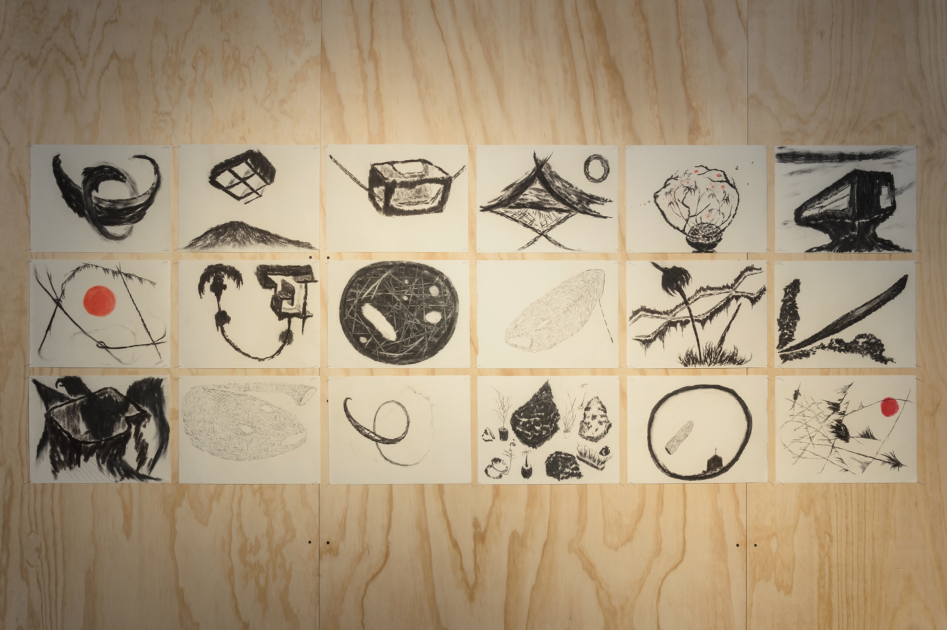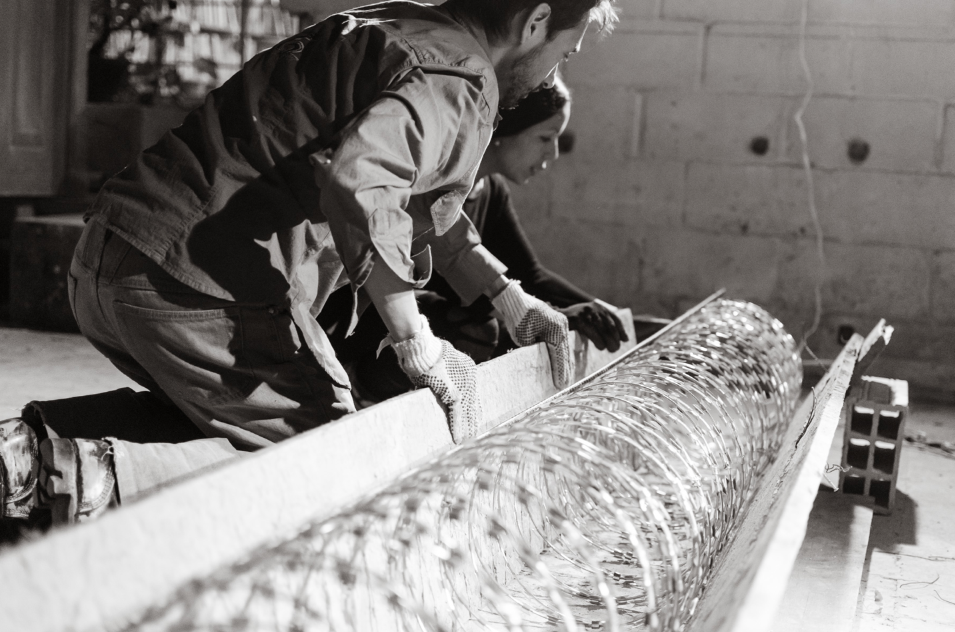Como resultado de tres residencias realizadas simultáneamente, Eduardo Abaroa (México), Matías Duville (Argentina) y Raura Oblitas (Perú) ponen a la vista del público procesos artísticos donde incorporan nuevas aproximaciones que nacen de la experiencia de habitar Honda por un tiempo.
Storyboard 1 de Eduardo Abaroa, ganador de la Beca Casa del Lago (México), es la primera entrega de un proyecto en proceso denominado Fotosíntesis. Los dibujos, que incluyen fragmentos de textos, y las esculturas en arcilla modeladas de manera muy rudimentaria (muchas veces con los ojos cerrados), son las primeras pistas de la historia de un futuro en el las plantas se han modificado genéticamente para satisfacer las necesidades sexuales de los humanos. Este historia fantástica parte del texto Ese Jardín, que Abaroa escribió hace tiempo y que acompaña los dibujos y cerámicas ubicados en los tres nichos en la pared de la sala. Fotosíntesis plantea la relación existente entre la ciencia ficción con lo no-visto o con aquello que todavía no se ha comprendido; una narrativa libre que tendrá elementos de video, dibujo, escultura y sonido, y que será exhibido en el 2015 en las salas de Casa del Lago en México. Para Abaroa este proyecto es también una aproximación embrionaria y crítica de la película de ciencia ficción como obra de arte total al estilo Hollywood.

Parque Osamenta de Matías Duville es un conjunto de piezas que funcionan como una instalación, pero que al mismo tiempo existen como cuerpos independientes. Una suerte de restos encontrados en aquel nuevo paisaje habitado momentáneamente por el artista durante su residencia.

La animación, proyectada en el hueco que forma la escalera de la casa, contiene la imagen de un pez que a simple vista parece vivo por su movimiento oscilante, pero que en una segunda apreciación devela su estado mortuorio enganchado de una rama. En el suelo de la sala yace un casco de motocicleta colmado de sal con una mancha violeta en su superficie, casi como el fragmento de un cuerpo que existió y que deja marca para transformarse en forma. La sal en los trabajos de Duville es un elemento recurrente que remite a una idea del mar, pero no en un sentido literal, sino entendido como ese área infinita e inabarcable en donde flotan las imágenes. El grupo de dibujos dispuesto en la pared al final de la sala conforma una suerte de arqueología de vestigios atravesados por aspectos formales de elementos observados en Honda.

Instant Father de Raura Oblitas es una pieza escultórica que la artista construye y ubica en el patio de FLORA. Esta pieza está fuertemente ligada a una investigación iniciada en 2013 en el distrito de Pueblo Libre de Lima. De allí surgen un conjunto de piezas denominadas Autoridad y Protección, que incorporan elementos arquitectónicos presentes en las casas de esta zona, para hablar sobre las posibles relaciones entre la falta de un proyecto político en una comunidad y el fervor religioso. Estos vínculos son los que hacen posible, en cierto punto, la aparición de personajes políticos fuertemente paternalistas en historia peruana -y del resto de países en América Latina- que se posicionan casi como un cristo “padre” protector. La búsqueda de una seguridad que se vuelve material en las rejas, alambres de púas, muros, fierros y concertinas que evidencian, de manera violenta, la única posible real protección en ciertos territorios.
En Honda, la ausencia de un proyecto político también se hace presente en el contraste entre una arquitectura que habla de su glorioso pasado como puerto del Magdalena y su presente como ciudad venida a menos, sin un cauce claro. La relación estructura – arquitectura y desarrollo social genera para Oblitas fricción en el paisaje de Honda.

Si bien, cada uno de los tres artistas evidencia búsquedas diversas, todas ellas son continuación o punto de empalme con procesos e imágenes ya presentes en sus trabajos, pero afectadas por el paisaje de Honda. La ubicación de las piezas en una vieja casa deteriorada por su uso, remite al poema No vive ya nadie en la casa del peruano César Vallejo que Raura Oblitas recuerda: “Las casas nuevas están más muertas que las viejas, porque sus muros son de piedra o de acero, pero no de hombres. Una casa viene al mundo, no cuando la acaban de edificar, sino cuando empiezan a habitarla”. Las palabras de Vallejo tienen también sentido, no sólo en la arquitectura de Honda que nos habla de aquello que fue, sino en esta vieja casa que parece convalecer, pero que sin embargo todavía respira a través de sus paredes.
—
As a result of three residences realized simultaneously, Eduardo Abaroa (Mexico), Matías Duville (Argentina) and Raura Oblitas (Peru) emphasize public artistic processes in which they incorporate new approaches that arise from the experience of living in Honda for a period of time.
Storyboard 1 by Eduardo Abaroa, winner of the Lake House (Mexico) Grant, is the first release of an project in process called Photosynthesis. The drawings, which include fragments of texts and clay sculptures modeled in a very rudimentary way (often with eyes closed), are the first clues to the story of a future where the plants were genetically modified to satisfy sexual human needs. This fantastic story, part of the text Ese Jardín, which Abaroa wrote once and the accompanying drawings and ceramics located in the three niches in the wall of the room. Photosynthesis presents the relationship between science fiction with the unseen or that which is not yet understood. Free narrative elements that include video, drawings, sculpture and sound will be exhibited in 2015 in Casa del Lago in Mexico. For Abaroa this project is also an embryonic approach and criticism of the science fiction film as an art form following Hollywood style.
Matthias Duville’s Parque Osamenta is a collection of pieces that work as an installation, but at the same time they exist as independent bodies. In some way these pieces were found in a new landscape that was temporarily inhabited by the artist during his residence.
The animation, projected into the hollow of a staircase, shows the image of a fish which at the first sight seems to be alive because of its rocking motion. But at second sight it appears to be dead, hanging on a moving branch. On the floor of the room lies a motorcycle helmet full of salt with a purple spot on its surface, almost like a fragment of a body that existed and that leaves a trace to finally transform itself into a form. The salt in Duville’s work is a recurring element that refers to the sea, but not in a literal sense, but understood as an area that is infinite and incomprehensible where the images float. The group of drawings, arranged in the wall at the end of the room, forms kind of an archeological arrangement showing the remains of the formal aspects, observed in Honda.
Instant Father from Raura Oblitas is a sculptural piece that the artist built and exhibited in FLORA´s back yard. This piece is linked to an investigation initiated in 2013 in the district Pueblo Libre in Lima. From this research, a set of pieces named “Protection and Authority” were created, which incorporated architectural elements of houses in this area, to discuss about the possible relationship between the lack of a political project in a community and religious fervor. At some point these links make possible that the appearance of strongly paternalistic political figures in Peruvian history -and the other countries in Latin America- are positioned almost like a Christ “father” protector. The search for security that becomes evident through bars, barbed wire, walls iron and concertinas, demonstrate in a violent way the only possible real protection in certain territories.
In Honda, the absence of a political project also becomes present in the contrast between an architecture that speaks of its glorious past as the Habour of River Magdalena and its present as a city that degraded in its growth, without a clear river bed. The relation structures – architecture and the social development generates friction for Oblitas Honda’s landscape.
Although, each of the three artists demonstrates diverse investigations, all of them are part of already begun processes or they are all part of ongoing research projects and already present images of their work, but that are affected by Honda’s landscape. The placement of the works developed in this residency in an old dilapidated house, refers to the poem No vive ya nadie en la casa written by Peruvian César Vallejo Raura and that Oblitas recalls: “The new houses are more dead than the old ones, because their walls are stone or steel, not human. A house begins to exist, not when it has been built, but when it has begun to be inhabited.” Vallejo’s words also make sense, not only in relation to Honda’s architecture that speaks to us through their history, but also in this house that seems to recover but nevertheless breathes through its walls.
